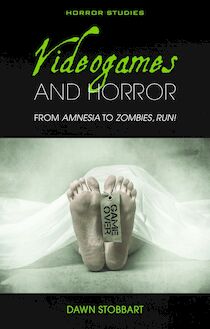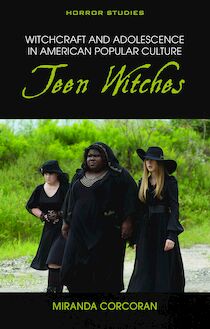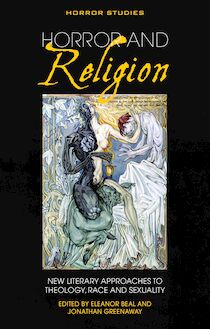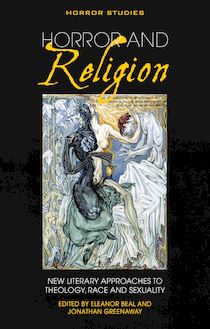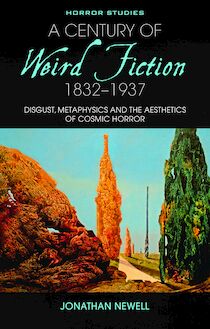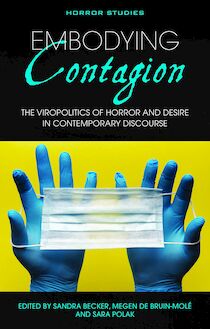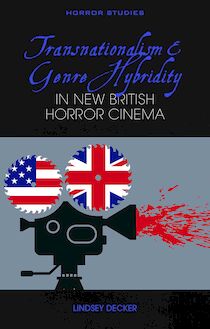-
 Univers
Univers
-
 Ebooks
Ebooks
-
 Livres audio
Livres audio
-
 Presse
Presse
-
 Podcasts
Podcasts
-
 BD
BD
-
 Documents
Documents
-
- Cours
- Révisions
- Ressources pédagogiques
- Sciences de l’éducation
- Manuels scolaires
- Langues
- Travaux de classe
- Annales de BEP
- Etudes supérieures
- Maternelle et primaire
- Fiches de lecture
- Orientation scolaire
- Méthodologie
- Corrigés de devoir
- Annales d’examens et concours
- Annales du bac
- Annales du brevet
- Rapports de stage
La lecture à portée de main
Vous pourrez modifier la taille du texte de cet ouvrage
Découvre YouScribe en t'inscrivant gratuitement
Je m'inscrisTransnationalism and Genre Hybridity in New British Horror Cinema , livre ebook
Découvre YouScribe en t'inscrivant gratuitement
Je m'inscrisEn savoir plus
Vous pourrez modifier la taille du texte de cet ouvrage
En savoir plus

Description
As an intervention in conversations on transnationalism, film culture and genre theory, this book theorises transnational genre hybridity – combining tropes from foreign and domestic genres – as a way to think about films through a global and local framework. Taking the British horror resurgence of the 2000s as case study, genre studies are here combined with close formal analysis to argue that embracing transnational genre hybridity enabled the boom; starting in 2002, the resurgence saw British horror film production outpace the golden age of British horror. Yet, resurgence films like 28 Days Later and Shaun of the Dead had to reckon with horror’s vilified status in the UK, a continuation of attitudes perpetuated by middle-brow film critics who coded horror as dangerous and Americanised. Moving beyond British cinema studies’ focus on the national, this book also presents a fresh take on long-standing issues in British cinema, including genre and film culture.
Acknowledgements
List of Illustrations
Introduction: Frights, Film Culture and Genre Hybrids: Examining Transnational Genre Hybridity in New British Horror Cinema
1 The ‘Bastard Child of Mainstream Cinema’: Middlebrow British Film Culture, Transnationalism and Horror
2 The Golden Age of British Cinema is Undead: British Zombies and The Social Realist Impulse
3 Hybrid Hoodie Horrors: Genre Localization and Britain’s Moral Panic
4 ‘A Famous Corpse’: Resurrecting Hammer’s Transnational Appeal
Conclusion – British Horror’s Perpetually ‘Dying Light’
Notes
References
Filmography
Index
Sujets
Informations
| Publié par | University of Wales Press |
| Date de parution | 01 mars 2021 |
| Nombre de lectures | 0 |
| EAN13 | 9781786837004 |
| Langue | English |
Informations légales : prix de location à la page 0,2850€. Cette information est donnée uniquement à titre indicatif conformément à la législation en vigueur.
Extrait
Transnationalism & Genre Hybridity
IN NEW BRITISH HORROR CINEMA
HORROR STUDIES
Series Editor
Xavier Aldana Reyes, Manchester Metropolitan University
Editorial Board
Stacey Abbott, Roehampton University
Linnie Blake, Manchester Metropolitan University
Harry M. Benshoff, University of North Texas
Fred Botting, Kingston University
Steven Bruhm, Western University
Steffen Hantke, Sogang University
Joan Hawkins, Indiana University
Agnieszka Soltysik Monnet, University of Lausanne
Bernice M. Murphy, Trinity College Dublin
Johnny Walker, Northumbria University
Preface
Horror Studies is the first book series exclusively dedicated to the study of the genre in its various manifestations – from fiction to cinema and television, magazines to comics, and extending to other forms of narrative texts such as video games and music. Horror Studies aims to raise the profile of Horror and to further its academic institutionalisation by providing a publishing home for cutting-edge research. As an exciting new venture within the established Cultural Studies and Literary Criticism programme, Horror Studies will expand the field in innovative and student-friendly ways.
Transnationalism & Genre Hybridity
IN NEW BRITISH HORROR CINEMA
LINDSEY DECKER
© Lindsey Decker, 2021
All rights reserved. No part of this book may be reproduced in any material form (including photocopying or storing it in any medium by electronic means and whether or not transiently or incidentally to some other use of this publication) without the written permission of the copyright owner except in accordance with the provisions of the Copyright, Designs and Patents Act. Applications for the copyright owner’s written permission to reproduce any part of this publication should be addressed to the University of Wales Press, University Registry, King Edward VII Avenue, Cardiff, CF10 3NS.
www.uwp.co.uk
British Library Cataloguing-in-Publication Data
A catalogue record for this book is available from the British Library.
ISBN: 978-1-78683-698-4
eISBN: 978-1-78683-700-4
The rights of Lindsey Decker to be identified as author of this work have been asserted in accordance with sections 77 and 79 of the Copyright, Designs and Patents Act 1988.
The publisher has no responsibility for the persistence or accuracy of URLs for any external or third-party internet websites referred to in this book, and does not guarantee that any content on such websites is, or will remain, accurate or appropriate.
Cover images used under licence from Shutterstock.com , artists NickJulia and mistery
Contents
Acknowledgements
List of Illustrations
Introduction: Frights, Film Culture and Genre Hybrids
Examining Transnational Genre Hybridity in New British Horror Cinema
1. The ‘Bastard Child of Mainstream Cinema’
Middlebrow British Film Culture, Transnationalism and Horror
2. The Golden Age of British Cinema is Undead
British Zombies and the Social Realist Impulse
3. Hybrid Hoodie Horrors
Genre Localisation and Britain’s Moral Panic
4. ‘A Famous Corpse’
Resurrecting Hammer’s Transnational Appeal
Conclusion: British Horror’s Perpetually ‘Dying Light’
Notes
References
Filmography
Acknowledgements
T HIS BOOK IS THE culmination of a series of unlikely events, and I’m grateful to everyone who has supported me along the way. In particular, thank you to Roger Hallas for working with me to transform the seed of an idea about genre hybridity in British horror films into the full-length study from which this book stems. Truly, I could not have asked for a better mentor. I would like to thank Steven Cohan and Kendall Phillips for their expertise, feedback and support, as well as Linnie Blake and Chris Hanson for their valuable comments on the project in its earlier stages.
Thank you to Sarah Lewis, the head of commissioning at the University of Wales Press, for her interest in my project and for helping to shepherd the project through the publication process. Thank you to the reviewers for their time and feedback.
I would like to thank my colleagues at Boston University’s Department of Film & Television for their interest in and support for this book.
Thanks to all of the various folks who have given me feedback on various pieces of this project at conferences, particularly Johnny Walker, Ann Davies, Rachel Fabian, Justin Smith, Dana Och and Geneveive Newman.
I would be remiss if I did not thank Dustin Potter, Staci Stutsman, Melissa Welshans, Peter Katz and Sarah Barkin for listening to me as I worked through ideas at various stages in this project.
And finally, thank you to my students – I try to touch on the concept of transnational genre hybridity in nearly every course I teach, and I have really enjoyed our conversations about it across the years.
List of Illustrations
Figure 1. The cover of the October 2002 issue of Sight & Sound .
Figure 2. Shots from Pure Rage (top to bottom: talking-head interview, lap dissolve, shot from 28 Days Later ).
Figure 3. Top, Attack the Block , Moses, played by John Boyega, being pursued by the flattened, undifferentiated mob of aliens. Bottom, Assault on Precinct 13 , the gang members emerge from the shadows in the mid-ground in the police station parking lot.
Figure 4. Top, Jennet’s smoky black ghost hand on Kipps’s left shoulder. Bottom, the smoke-like ghost of Kayako hovering over Sachie.
Figure 5. Top, Nathaniel in The Woman in Black . Bottom, Toshio in Ju-on: The Grudge.
Figure 6. The cover of the November 2012 issue of Sight & Sound.
Figure 7. Whitehead’s body is turned into itself.
Figure 8. From left to right, top to bottom, making an eye in Under the Skin.
Introduction: Frights, Film Culture and Genre Hybrids
Examining Transnational Genre Hybridity in New British Horror Cinema
Although the increased visibility of British horror cinema in the new millennium has made it difficult to ignore, it is significant that the films with the greatest critical and cultural impact have been those with the highest levels of generic impurity. Whilst the similarly Romero-influenced Shaun of the Dead and 28 Days Later benefited from their borrowings from other genres – respectively, comedy and post-apocalyptic science fiction – the British horror film still lacks critical respectability. A slightly different fate has befallen films that can be more closely identified with the science fiction genre. Although fewer in number, these have enjoyed greater prestige. (James Leggott, from his Contemporary British Cinema: From Heritage to Horror 1 )
T HE ABOVE QUOTATION from British cinema scholar James Leggott’s excellent Contemporary British Cinema primer, published in 2008, crystallises the key concerns of this project by bringing together new British horror cinema of the 2000s, genre hybridity, transnationality and middlebrow British film culture. Leggott cites the fact that the most critically significant British horror films of the first decade of the 2000s were genre hybrids – characterised by, as he puts it, ‘generic impurity’. He casts this hybridity, or ‘impurity’, as negative. It likely helped Edgar Wright’s Shaun of the Dead (2004) and Danny Boyle’s 28 Days Later (2002) but not enough to make them as prestigious as more straightforward genre films that fit more solidly within a single genre like science fiction. More importantly, this excerpt positions Shaun and 28 Days Later as transnational hybrids, primarily influenced by American director George Romero’s zombie films but made better by their fusion with genres Leggott has earlier framed as explicitly British. However, this recourse to home-grown genres could not save these Americanised British horror films – indeed, the transnationality of the genre hybridity seems to be part of what keeps the films from critical respectability, in opposition to films seen as more uncomplicatedly British. But this respectability is being adjudicated and found wanting within the context of a particular strand of British film culture, one which dominates many discussions of British film, academic and otherwise, and has influenced Leggott’s writing here: middlebrow British film culture.
In this book, I theorise the ways that transnational genre hybridity can function in a film through formal elements and genre tropes. I use the 2000s British horror resurgence as a vital case study through which to investigate this phenomenon. The term ‘resurgence’ has been used fairly widely in popular and academic publications to discuss the British horror boom of the 2000s. While Geoffrey Macnab may have been the first to mention the ‘UK horror picture’ and its ‘remarkable resurgence’, it appears that Anne Billson’s review of David Pirie’s A New Heritage of Horror was the first instance of the full phrase ‘British horror resurgence’. 2 In part, this period of British horror cinema presents such a compelling site because of middlebrow British film culture and its relationship with both the horror genre and the British film industry. The British film-makers whose work I examine in this book used transnational genre hybridity in several key ways within a set of prestigious and successful new British horror films. This allowed these film-makers a means to respond to discourses circulating about the industry and genre within middlebrow British film culture. In doing so, transnational genre hybridity became a tool for cultural engagement as well as cultural legitimation. Film-makers could respond to a key strand of film culture that was discussing and shaping their work, which further allowed them to influence several of the discourses about British horror circulating within that film culture.
Films that engage in transnational genre hybridity draw on formal and narrative tropes from specific genres associated with foreign national cinemas and combine them with tropes from long-standing and emergent genres from their own national cinema. This transnational genre hybridity
-
 Univers
Univers
-
 Ebooks
Ebooks
-
 Livres audio
Livres audio
-
 Presse
Presse
-
 Podcasts
Podcasts
-
 BD
BD
-
 Documents
Documents
-
Jeunesse
-
Littérature
-
Ressources professionnelles
-
Santé et bien-être
-
Savoirs
-
Education
-
Loisirs et hobbies
-
Art, musique et cinéma
-
Actualité et débat de société
-
Jeunesse
-
Littérature
-
Ressources professionnelles
-
Santé et bien-être
-
Savoirs
-
Education
-
Loisirs et hobbies
-
Art, musique et cinéma
-
Actualité et débat de société
-
Actualités
-
Lifestyle
-
Presse jeunesse
-
Presse professionnelle
-
Pratique
-
Presse sportive
-
Presse internationale
-
Culture & Médias
-
Action et Aventures
-
Science-fiction et Fantasy
-
Société
-
Jeunesse
-
Littérature
-
Ressources professionnelles
-
Santé et bien-être
-
Savoirs
-
Education
-
Loisirs et hobbies
-
Art, musique et cinéma
-
Actualité et débat de société
- Cours
- Révisions
- Ressources pédagogiques
- Sciences de l’éducation
- Manuels scolaires
- Langues
- Travaux de classe
- Annales de BEP
- Etudes supérieures
- Maternelle et primaire
- Fiches de lecture
- Orientation scolaire
- Méthodologie
- Corrigés de devoir
- Annales d’examens et concours
- Annales du bac
- Annales du brevet
- Rapports de stage
